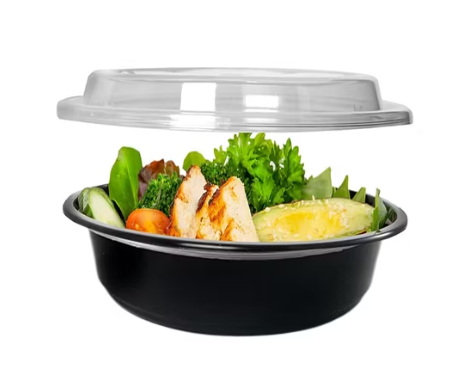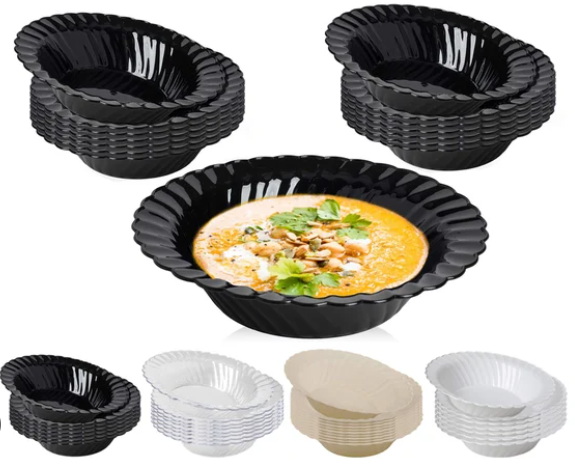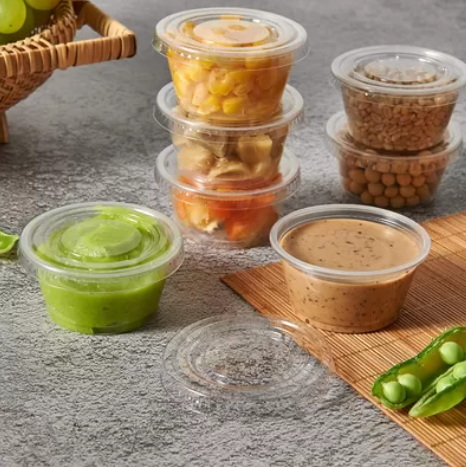
Content Menu
● Introduction to Disposable Plastic Soup Bowls
>> Key Features of Disposable Plastic Soup Bowls
● Safety Concerns with Hot Liquids
>> Chemical Leaching
>>> BPA and Phthalates
>> Heat Resistance and Microwave Safety
>>> Choosing Safe Plastic Containers
● Eco-Friendly Alternatives
>> Biodegradable Materials
● Choosing the Right Disposable Bowl
>> Comparison of Materials
● Environmental Impact
>> Sustainable Practices
● Health Risks of Plastic Containers
>> Minimizing Health Risks
● Regulatory Measures
>> Impact on Businesses
● Future of Disposable Soup Bowls
>> Biocomposite Materials
● Conclusion
● FAQ
>> 1. Are All Plastic Soup Bowls Microwave Safe?
>> 2. What Are the Health Risks of Using Plastic Containers for Hot Food?
>> 3. Are Eco-Friendly Disposable Bowls Suitable for Hot Liquids?
>> 4. How Can I Minimize Chemical Leaching from Plastic Containers?
>> 5. What Are the Best Eco-Friendly Alternatives to Plastic Soup Bowls?
● Citations:
Disposable plastic soup bowls with lids have become an integral part of modern convenience, offering an easy and efficient way to enjoy hot soups on the go. However, concerns about their safety, particularly when used with hot liquids, have sparked debates among consumers and health experts. This article delves into the safety aspects of using disposable plastic soup bowls with lids for hot liquids, exploring the materials used, potential health risks, and eco-friendly alternatives.

Introduction to Disposable Plastic Soup Bowls
Disposable plastic soup bowls are popular due to their durability, ease of use, and affordability. They are often made from various types of plastic, such as polypropylene (PP), polystyrene (PS), and polyethylene (PE), each with its own set of properties and safety considerations.
Key Features of Disposable Plastic Soup Bowls
- Durability and Heat Resistance: Plastic bowls are known for their ability to withstand hot liquids without leaking, making them suitable for soups and stews.
- Microwave Safety: Some plastic bowls are labeled as microwave-safe, allowing users to reheat their soups conveniently.
- Convenience: They eliminate the need for washing and storage, ideal for busy lifestyles or events.
However, these benefits come with potential drawbacks:
- Chemical Leaching: Heat can cause chemicals like BPA and phthalates to leach into food, posing health risks.
- Environmental Impact: Most plastic bowls are not biodegradable and contribute to plastic waste.
Safety Concerns with Hot Liquids
Chemical Leaching
When hot food is placed in plastic containers, there's a risk that heat can cause chemicals from the plastic to leach into the food. These chemicals, such as Bisphenol A (BPA) and phthalates, have been associated with health risks, including reproductive disorders and cancer concerns.
BPA and Phthalates
- BPA: Used to harden plastics, BPA can mimic hormones in the body, leading to potential health issues.
- Phthalates: These chemicals are linked to reproductive issues and are often found in flexible plastics.
BPA and phthalates are considered endocrine disruptors, substances that mimic human hormones and can cause hormonal imbalances and other health problems[2]. The risk of chemical leaching increases with heat, especially when microwaving food in plastic containers[1][5].
Heat Resistance and Microwave Safety
Not all plastics are suitable for microwaving. Containers that are not designed for microwave use can release harmful chemicals into the food when exposed to heat, posing potential health risks.
Choosing Safe Plastic Containers
- Look for BPA-Free Labels: Ensure the plastic is free from harmful chemicals.
- Check Microwave Safety: Only use containers labeled as microwave-safe.
When selecting plastic containers for hot foods, it's crucial to choose those made from safe materials and designed for microwave use. Premium PP plastic soup bowls, for example, are known for their heat resistance and durability, making them a safer option for hot liquids[1].
Eco-Friendly Alternatives
As concerns about plastic waste grow, consumers are turning to eco-friendly alternatives for disposable soup bowls.
Biodegradable Materials
- PLA (Polylactic Acid): Made from cornstarch, PLA bowls are compostable but have limitations with high heat.
- Bagasse: Derived from sugarcane, bagasse bowls are fully compostable and can handle hot liquids well.
- Paper Bowls: While not as durable as plastic, paper bowls are lightweight and suitable for casual use.
Bagasse bowls, in particular, offer a sustainable solution for hot soups. They are made from the residue of sugarcane processing, which leaves a significantly smaller carbon footprint compared to traditional paper and plastic products[3].

Choosing the Right Disposable Bowl
When selecting disposable bowls for hot soups, consider the following factors:
- Material: Opt for heat-resistant materials like BPA-free plastic or eco-friendly options.
- Microwave Safety: Ensure the bowl is labeled as microwave-safe.
- Eco-Friendliness: Consider compostable or biodegradable bowls for sustainability.
Comparison of Materials
| Material | Heat Resistance | Microwave Safety | Eco-Friendliness |
| BPA-Free PP | High | Yes | Low |
| PLA | Limited | Generally No | High |
| Bagasse | High | Yes | High |
| Paper | Limited | Limited | Medium |
Environmental Impact
The environmental impact of disposable plastic soup bowls is significant. Most plastic bowls are not biodegradable and contribute to plastic waste, which can end up in oceans and harm marine life. In contrast, eco-friendly alternatives like bagasse and PLA bowls are compostable, reducing waste and supporting sustainable practices.
Sustainable Practices
- Reduce Plastic Use: Opt for reusable bowls when possible.
- Recycle: Ensure that any plastic used is recyclable.
- Compost: Use compostable bowls to reduce landfill waste.
Health Risks of Plastic Containers
Plastic containers, especially those containing BPA and phthalates, pose health risks when used for hot foods. These chemicals can leach into food, potentially causing hormonal imbalances and other health issues[2][8].
Minimizing Health Risks
- Avoid Heating in Plastic: Limit the use of plastic containers for hot foods.
- Choose BPA-Free Options: Opt for containers labeled as BPA-free.
- Use Eco-Friendly Alternatives: Consider bagasse or PLA bowls for a safer option.
Regulatory Measures
Regulatory measures are being implemented to reduce the use of single-use plastics. For example, some regions have banned certain types of single-use plastic containers, encouraging businesses to adopt more sustainable packaging solutions[7].
Impact on Businesses
- Adapting to Regulations: Businesses must adapt to new regulations by using eco-friendly packaging.
- Consumer Demand: Consumers increasingly demand sustainable options, driving market change.
Future of Disposable Soup Bowls
The future of disposable soup bowls is likely to be shaped by consumer demand for sustainability and regulatory pressures to reduce plastic waste. Eco-friendly materials like bagasse and biocomposites are gaining popularity as they offer a sustainable alternative to traditional plastics.
Biocomposite Materials
Biocomposite materials, made from natural fibers like bamboo and rice husk, offer a durable and recyclable option for soup bowls. These materials are free from harmful chemicals like BPA and phthalates, making them a safer choice for consumers[6].
Conclusion
Disposable plastic soup bowls with lids offer convenience but come with safety concerns, particularly regarding chemical leaching and environmental impact. While they can be safe if used correctly, opting for eco-friendly alternatives like PLA or bagasse bowls can mitigate these risks. Always choose BPA-free, microwave-safe options to ensure safety.

FAQ
1. Are All Plastic Soup Bowls Microwave Safe?
No, not all plastic soup bowls are microwave-safe. It's crucial to check the packaging for microwave safety labels to avoid potential health risks.
2. What Are the Health Risks of Using Plastic Containers for Hot Food?
Using plastic containers for hot food can lead to chemical leaching, including BPA and phthalates, which have been linked to various health issues.
3. Are Eco-Friendly Disposable Bowls Suitable for Hot Liquids?
Some eco-friendly options, like bagasse bowls, are suitable for hot liquids. However, materials like PLA have heat limitations and are best for warm foods.
4. How Can I Minimize Chemical Leaching from Plastic Containers?
To minimize chemical leaching, use BPA-free containers, avoid heating food in plastic, and opt for eco-friendly alternatives when possible.
5. What Are the Best Eco-Friendly Alternatives to Plastic Soup Bowls?
The best eco-friendly alternatives include PLA, bagasse, and bamboo bowls, which are biodegradable and compostable, reducing environmental impact.
Citations:
[1] https://customcupfactory.com/blogs/news/are-plastic-soup-containers-safe-best-practices-for-ensuring-customer-safety
[2] https://goqii.com/blog/?p=6915
[3] https://www.biogreenchoice.com/products/12-oz-compostable-fiber-bagasse-soup-bowl
[4] https://www.innaturepack.com/the-best-disposable-soup-bowls-with-lids-for-hot-soup/
[5] https://customcupfactory.com/blogs/news/is-it-safe-to-put-hot-food-in-a-plastic-container
[6] https://eha.eco/modern_soup_bowl_set_from_biocomposites/
[7] https://www.replacethewaste.sa.gov.au/guideline-food-containers
[8] https://www.center4research.org/plastic-wrap-plastic-food-containers-safe/
[9] https://www.biopak.com/uk/containers-lids/bowls
[10] https://getbiopak.com/are-paper-cups-safe-for-hot-drinks-a-comprehensive-guide/
[11] https://www.bbc.co.uk/food/articles/are_plastic_food_storage_containers_safe
[12] https://diyecobox.com/best-disposable-bowls-for-hot-soup-top-picks/
[13] https://cuttheplastics.hk/images/download/Catering%20Sector.pdf
[14] https://www.nblinhua.com/news/industry-news/how-to-address-concerns-about-the-potential-health-risks-of-using-plastic-plate-bowl-to-serve-hot-food-or-liquids.html
[15] https://www.bioleaderpack.com/top-8-best-disposable-bowls-for-hot-soup-durable-leak-proof-eco-friendly-choices/
[16] https://plasticsbanwa.com.au/items/
[17] https://www.mayoclinic.org/healthy-lifestyle/nutrition-and-healthy-eating/expert-answers/bpa/faq-20058331
[18] https://www.sincerepacking.com/sustainable-paper-bowls-eco-friendly-alternative-to-plastic-or-paper-options
[19] https://www.info.gov.hk/gia/general/200512/07/P200512070119.htm
[20] https://greenpaperproducts.com/collections/compostable-bowls

















